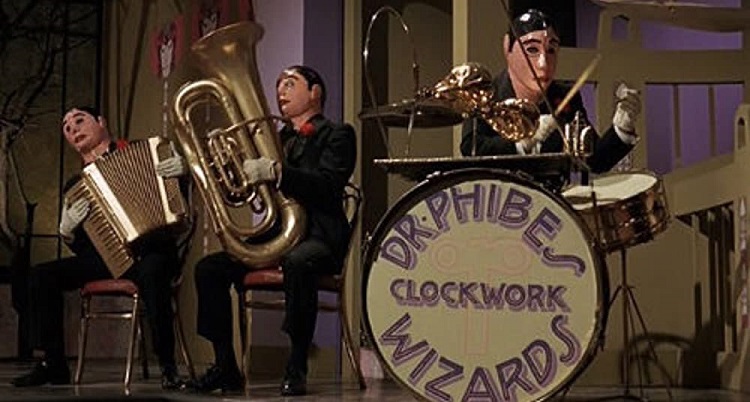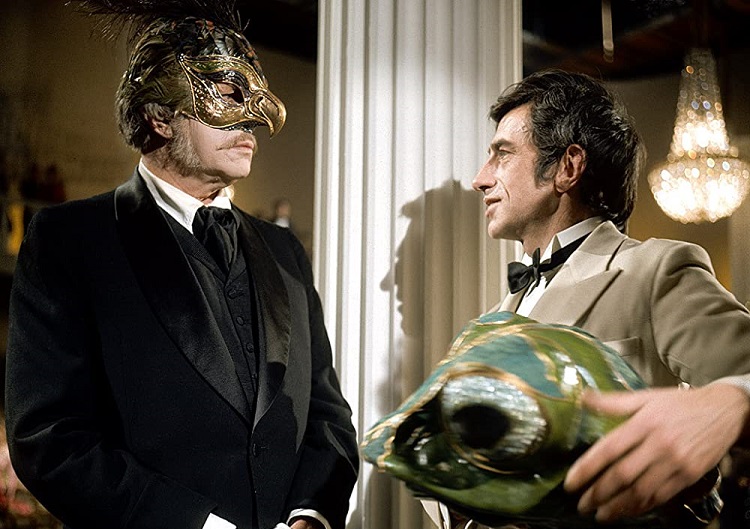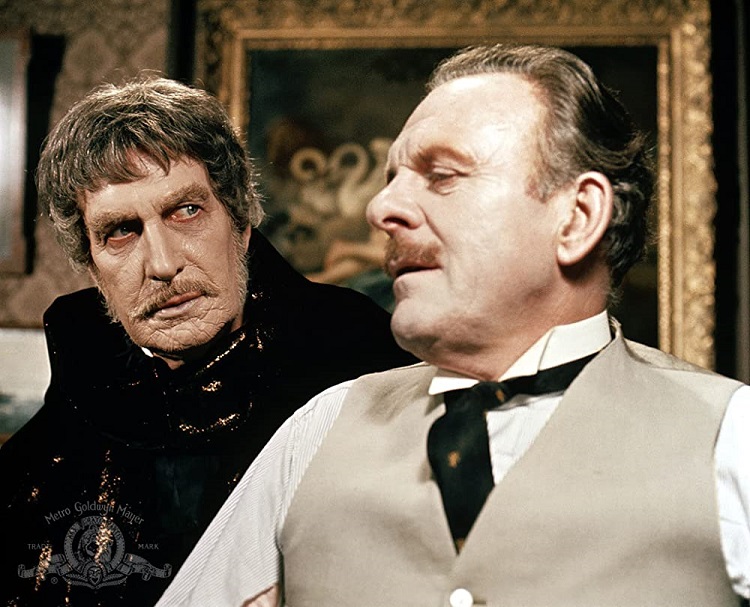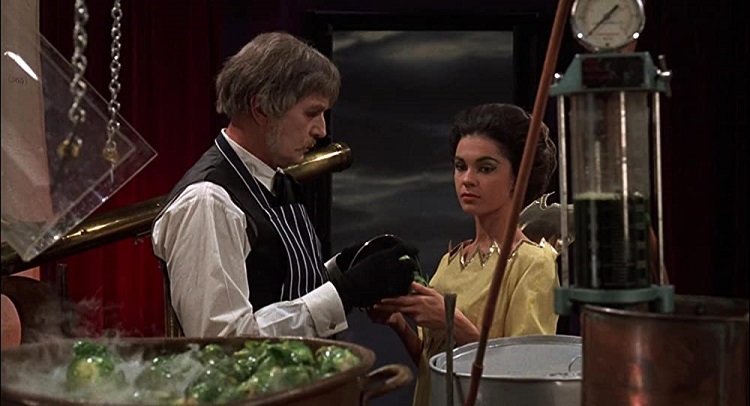Nine Killed Her! Nine Shall Die! | The Abominable Dr Phibes Fifty Years On
The opening of The Abominable Dr Phibes feels like an unnerving dream. A mysterious figure robed and hooded in black plays the pipe organ for a mysterious beautiful woman, accompanied by an eerie orchestra of animatronic robots, before the pair of them head to a sleeping man’s house and murder him with vampire bats. The film then cuts to the man being discovered by his manservant the next morning, leading to the scene being investigated by a set of long-suffering (and vaguely comedic) police detectives. The tonal whiplash between these scenes is all part of the appeal of Phibes, a film that I think is one of the best in Vincent Price’s very respectable career.

Vincent Leonard Price was born in Missouri 110 years ago this month. His father was the president of a candy company, his grandfather invented baking powder. He became interested in acting while studying for an art degree in London. He started on the stage but soon moved into films, and one of his first major roles was as the title character in The Invisible Man Returns. Like the actor Claude Rains seven years earlier, Price was cast because of his amazing voice (since he would be offscreen for most of the picture), and like Claude Rains the role made him a star. Films like Dragonwyck and Champagne for Caesar proved he was no flash in the pan, but it wasn’t until the 1960s that he ascended to become a true horror icon. A string of appearances in Poe adaptations by Roger Corman, beginning with House of Usher in 1960, made Vincent Price’s name synonymous with gothic horror forever after.
In 1964 (the same year Price went to Rome to film The Last Man On Earth) two screenwriters named James Whiton and William Goldstein created a 17 page treatment for a dark gothic horror named The Fingers of Dr Pibe. They sold it to AIP (America International Pictures, who had produced Corman and Price’s Poe films), and turned it into a screenplay for them in 1969 (under the new title of The Curses of Dr Pibe.) AIP’s resident story Robert Blees might be the one who changed the character’s name to Phibes. He was definitely responsible for introducing the comedic elements into the film, alongside the director Robert Fuest. Fuest had cut his teeth directing episodes of The Avengers which had a similar mixture of dramatic and comedic tones.
It’s unsurprising that AIP saw the script as a vehicle for Price, as the role of Dr Phibes suits him perfectly. Since Phibes was badly injured and burned in a car accident he wears a mask to hide his scars, meaning that for almost all of the movie Price is made up to look like he’s wearing a mask of his own face. Since this means it cannot move, Price is only able to act with his eyes. Phibes is also unable to speak thanks to injuries to his vocal chords, so his disembodied voice is transmitted from a cord he plugs into his neck. The unnatural cadence and maniacal emotion Price puts into his voice makes Phibes seem almost otherworldly, while the genuine pain he adds gives us a level of sympathy for the murderous doctor.

That pain comes from the death of Phibes’ wife on the operating table, a death he is determined to avenge. Phibes blames the surgical team and is gradually murdering them off in macabre and bizarre ways, leaving his greatest revenge for their leader Dr Vesalius. Vesalius is played by Joseph Cotten, an actor best known for his role in Citizen Kane and his many Broadway successes. He and Price had acted together on stage, as part of Orson Welles’ Mercury Theatre productions. (Peter Cushing was originally approached to play the part, but his wife was very sick at the time and he was turning down all work to be with her.) Aiding Phibes in his revenge is the mysterious Vulnavia, played by Virginia North. North was a former model and this was her fifth and final movie role. (She was replaced by another former model, Valli Kemp, in the sequel.) They operate out of Phibes’ mansion, a glorious art deco pad complete with a pipe organ built into a lift for Phibes to dramatically appear playing while Vulnavia wears yet another improbable but beautiful dress.
Opposing Phibes and Vulnavia are the forces of law and order, led by Peter Jeffrey as Inspector Trout. Jeffrey was a well-known English TV actor. The movie was filmed and set in England, during the 1920s, and outside of Price and Cotten (who got star billing on the poster) the actors are almost all English. Trout is almost portrayed as comic relief, hamstrung by his superiors and always a step behind Phibes. Indeed at several points Vesalius takes the lead in the investigation (perhaps a way to get star Cotten more screen time). The rest of the cast are populated by more actors who would have been very familiar to British TV viewers, like Peter Gilmore. Possibly the most famous of them is the comedian Terry-Thomas, best known for playing “absolute cads”, who has a brief but memorable appearance as one of Phibes’ victims.

Phibes is an odd film that’s not without its flaws. For example, one very strange thing to me is that the film treats the Biblical “Ten Plagues of Egypt” as if they’re some obscure myth nobody would have ever heard of. Since this results in us getting a performance from the great Hugh Griffith as a rabbi, I’m not complaining. Everything does move fast enough for the cracks not to show though, and the mesmerising performance by Price keeps it all together. Everything builds to a haunting and surprisingly sentimental finale.
The movie did very well at the box office, far outperforming AIP’s expectations. (This despite a legendarily bad poster that misrepresents the film and spoils Phibes’ “true face”.) A sequel was swiftly greenlit, that sadly retcons the ending of the first film and also decides that Phibes is now a wizard seeking to resurrect his dead wife. Some people prefer the second movie, but I personally find it unnecessary (if fun in places). To me the true sequel to the film is 1973’s Theatre of Blood, where Vincent Price once again plays a man thought dead by the world and out for revenge. This time he’s a former Shakespearian actor, and again he’s aided by a beautiful woman: his daughter, played by Diana Rigg. (In a coincidence, Rigg had played Virginia North’s step-daughter in the Bond film On Her Majesty’s Secret Service.) The movie was one of Price’s favourites because he was able to deliver many classic Shakespeare monologues, something he hadn’t managed in his theatre career.

In the following years several attempts to revive the Phibes franchise withered on the vine. A TV series was suggested later in the 70s but nothing came of it. And a story treatment in the 1980s for The Seven Fates of Dr Phibes was very warmly received by Price, but by then the horror box office was dominated by slasher movies and the distributors were not confident in the film. (The treatment is available online.) Other sequel proposals such as Phibes Ressurectus and The Bride of Dr Phibes met similar fates. In more recent years Phibes appeared in several issues of the Vincent Price Presents comic book around 2010, and an independent film version of Seven Fates was even talked about (though I don’t think it ever materialised.)
The true legacy of Phibes lies in the influence it’s had on the horror genre over the last 50 years. The film became a cult classic (legend has it that Keith Moon was watching it the night he died). There’s a lot of Dr Phibes’ influence in Sam Raimi’s Darkman which is also about someone heavily scarred disguising themselves and seeking revenge. The concept of “elaborate murder themes” reappears in films like Se7en, while there are several of Jigsaw’s challenges in the Saw franchise that are similar to Phibes’ murders. More than that, the film became emblematic of the “gothic revival” period that characterised the 60s and early 70’s horror film. There’s a charm among the grue that remains sadly absent from modern horror movies, and I think they’re the poorer for it.

